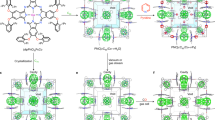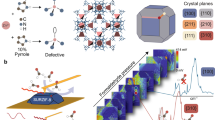Abstract
For the past decade, the emerging class of porous metal–organic frameworks1,2,3 has been becoming one of the most promising materials for the construction of extralarge pore networks in view of potential applications in catalysis, separation and gas storage. The knowledge of the atomic arrangements in these crystalline compounds is a key point for the understanding of the chemical and physical properties. Their crystal size limits the use of single-crystal diffraction analysis, and synchrotron radiation facilities4 may allow for the analysis of tiny crystals. We present here a microdiffraction set-up for the collection of Bragg intensities, which pushes down the limit to the micrometre scale by using a microfocused X-ray beam of 1 μm. We report the structure determination of a new porous metal–organic-framework-type aluminium trimesate (MIL-110) from a single crystal of a few micrometres length, showing very weak scattering factors owing to the composition of the framework (light elements) and very low density. Its structure is built up from a honeycomb-like network with hexagonal 16 Å channels, involving the connection of octahedrally coordinated aluminium octameric motifs with the trimesate ligands. Solid-state NMR (27Al,13C,1H) and molecular modelling are finally considered for the structural characterization.
This is a preview of subscription content, access via your institution
Access options
Subscribe to this journal
Receive 12 print issues and online access
$259.00 per year
only $21.58 per issue
Buy this article
- Purchase on Springer Link
- Instant access to full article PDF
Prices may be subject to local taxes which are calculated during checkout




Similar content being viewed by others
References
Yaghi, O. M. et al. Reticular synthesis and the design of new materials. Nature 423, 705–714 (2003).
Kitagawa, S., Kitaura, R. & Noro, S.-I. Functional porous coordination polymers. Angew. Chem. Int. Edn 43, 2334–2375 (2004).
Férey, G. et al. A chromium terephthalate-based solid with unusually large pore volumes and surface area. Science 309, 2040–2042 (2005).
Riekel, C., Burghammer, M. & Schertler, G. Protein crystallographically microdiffraction. Curr. Opin. Struct. Biol. 15, 556–562 (2005).
Férey, G. et al. A hybrid solid with giant pores prepared by a combination of targeted chemistry, simulation, and powder diffraction. Angew. Chem. Int. Edn 43, 6296–6301 (2004).
Mellot-Draznieks, C., Dutour, J. & Férey, G. Computational study of MOF phases and structure prediction. Angew. Chem. Int. Edn 43, 6290 (2004).
Loiseau, T. et al. A rationale for the large breathing of the porous aluminum terephthalate (MIL-53) upon hydration. Chem. Eur. J. 10, 1373–1382 (2004).
Loiseau, T. et al. Hydrothermal synthesis and crystal structure of a new three-dimensional aluminium–organic framework MIL-69 with 2,6-naphthalenedicarboxylate (ndc), Al(OH)(ndc). H2O. C.R. Chim. 8, 765–772 (2005).
Loiseau, T. et al. MIL-96, a porous aluminum trimesate 3D structure constructed from a hexagonal network of 18-membered rings and mu3-oxo-centered trinuclear units. J. Am. Chem. Soc. 128, 10223–10230 (2006).
Schubert, M., Müller, U., Tonigold, M. & Ruetz, R. Methods for producing organometallic framework materials containing main group metal ions. Patent WO 2007/023134 A1 (2007).
Riekel, C., Burghammer, M. & Müller, M. Microbeam small-scattering experiments and their combination with microdiffraction. J. Appl. Crystallogr. 33, 421–423 (2000).
Sheldrick, G. M. SHELXS-86—A program for automatic solution of crystal structures. Acta Crystallogr. A 46, 467–473 (1990).
Sheldrick, G. M. SHELX-97—A Program for Crystal Structure Refinement. Release 97-2 (Univ. of Goettingen, Germany, 1997).
Farrugia, L. J. WinGX suite for small-molecule single-crystal crystallography. J. Appl. Crystallogr. 32, 837–838 (1999).
Brese, N. E. & O’Keeffe, M. Bond-valence parameters for solids. Acta Crystallogr. B 47, 192–197 (1991).
Casey, W. H., Olmstead, M. M. & Phillips, B. L. A new aluminum hydroxide octamer, [Al8(OH)14(H2O)18](SO4)5.16H2O. Inorg. Chem. 44, 4888–4890 (2005).
Di Renzo, F., Galarneau, A., Trens, P. & Fajula, F. in Handbook of Porous Solids Vol. 3 (eds Schüth, F., Sing, K. W. & Weitkamp, J.) 1311–1395 (Wiley-VCH, Weinheim, 2002).
Riekel, C. New avenues in X-ray microbeam experiments. Rep. Prog. Phys. 63, 233–262 (2000).
Amoureux, J. P. & Fernandez, C. Triple, quintuple and higher order multiple quantum MAS NMR of quadrupolar nuclei. Solid State NMR 10, 211–223 (1998).
Neder, R. B. et al. Single-crystal diffraction by submicrometer sized kaolinite; observation of Bragg reflections and diffuse scattering. Z. Kristallogr. 211, 763 (1996).
Burghammer, M. Röntgenbeugungsexperimente an mikrometer- und submikrometer-grossen Einkristallen. Thesis, Ludwig Maximilians Univ., Munich (1997).
Gaillot, A. C. et al. Structure of synthetic K-rich birnessite obtained by high-temperature decompostion of KMnO4. I. Two-layer polytype from 800C experiment. Chem. Mater. 15, 4666–4678 (2003).
Li, J., Edwards, P., Burghammer, M., Villa, C. & Schertler, G. F. X. Structure of bovine rhodosin in a trigonal crystal form. J. Mol. Biol. 343, 1409–1438 (2004).
Popov, D. et al. Amylose single crystals: Unit cell refinement from synchrotron radiation microdiffraction data. Macromolecules 39, 3704–3706 (2006).
Nelson, R. et al. Structure of the cross-beta spine of amyloid-like fibrils. Nature 435, 773–778 (2005).
Luecke, H., Schobert, B., Lanyi, J. K., Spudich, E. N. & Spudich, J. L. Crystal structure of sensory rhodopsin II at 2. 4 A: Insights into color tuning and transducer interaction. Science 293, 1499–1503 (2001).
Pebay-Peyroula, E., Rummel, G., Rosenbusch, J. P. & Landau, E. M. Bacteriorhodopsin. Science 277, 1676–1681 (1997).
Berthet-Colominas, C. et al. Head-to-tail dimers and interdomain flexibility revealed by the crystal structure of HIV-1 capsid protein (p24) complexed with a monoclonal antibody Fab. The EMBO J. 18, 1124–1136 (1999).
Emsley, J., Knight, C. G., Farndale, R. W. & Barnes, M. J. Structure of the integrin alpha 2 beta 1-binding collagen peptide. J. Mol. Biol. 335, 1019 (2004).
Author information
Authors and Affiliations
Contributions
C.V., N.G., T.L. and G.F. were involved in the synthesis and characterization of porous metal–organic framework materials. D.P., M.B. and C.R. were involved in the development of the new microdiffraction set-up at station ID 13 (ESRF). M.H. and F.T. were involved in the solid-state NMR characterization. C.M.-D. was involved in computer molecular modelling.
Corresponding author
Ethics declarations
Competing interests
The authors declare no competing financial interests.
Supplementary information
Supplementary Information
Supplementary materials, tables and images (PDF 255 kb)
Rights and permissions
About this article
Cite this article
Volkringer, C., Popov, D., Loiseau, T. et al. A microdiffraction set-up for nanoporous metal–organic-framework-type solids. Nature Mater 6, 760–764 (2007). https://doi.org/10.1038/nmat1991
Received:
Accepted:
Published:
Issue Date:
DOI: https://doi.org/10.1038/nmat1991
This article is cited by
-
A robust ultra-microporous cationic aluminum-based metal-organic framework with a flexible tetra-carboxylate linker
Communications Chemistry (2023)
-
Size almost doesn't matter
Nature Materials (2007)




